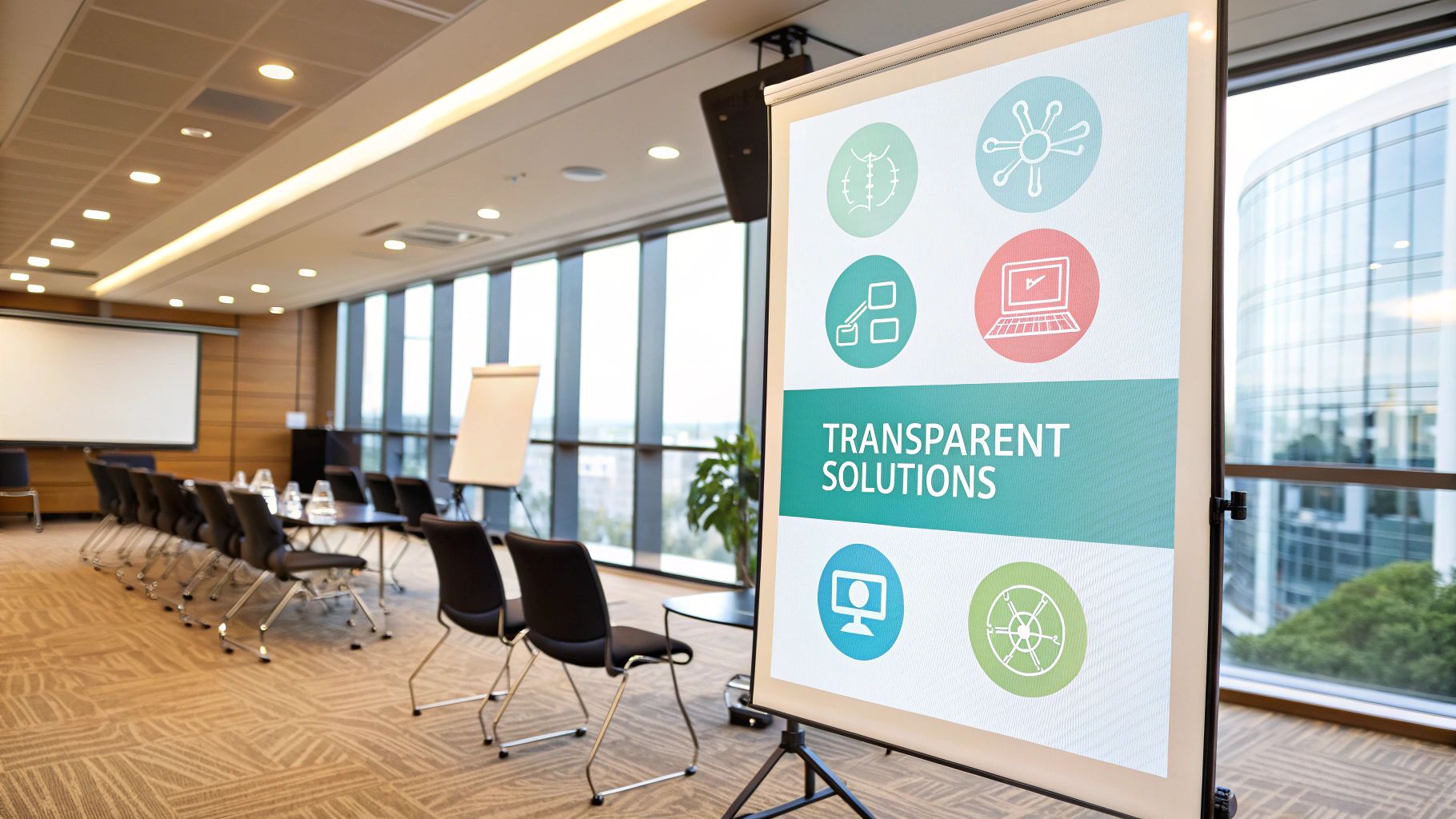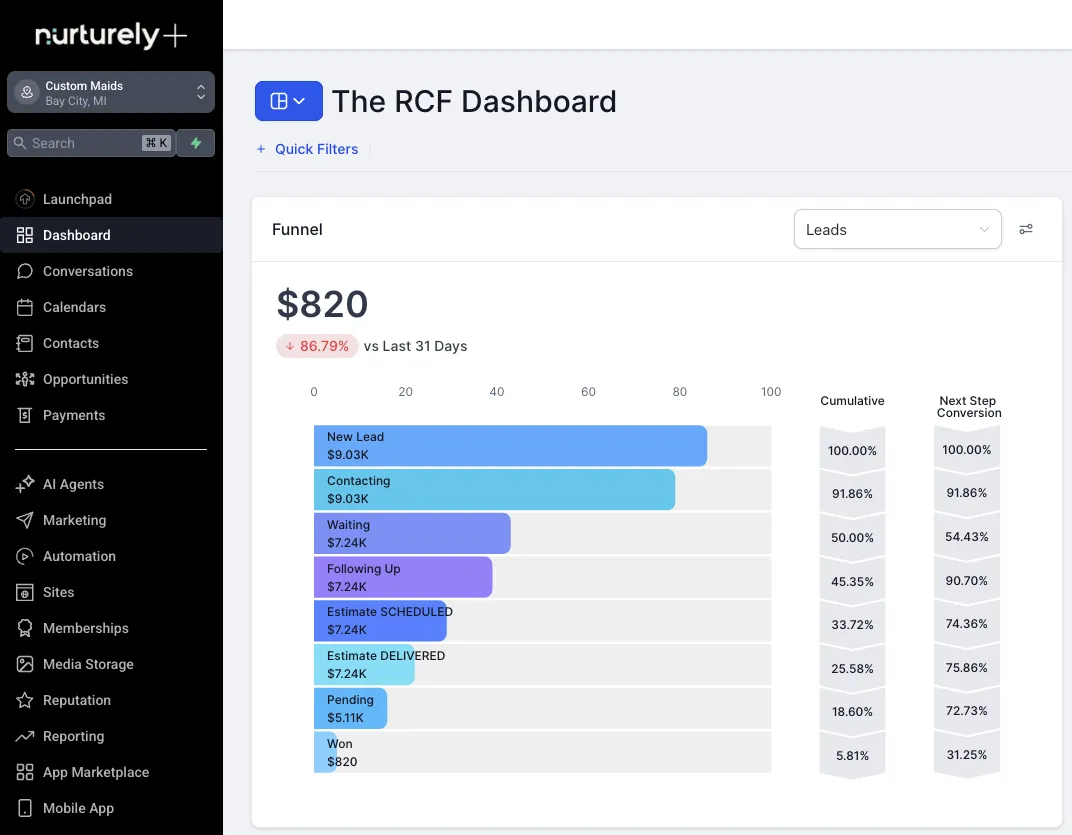7 Client Communication Best Practices
7 Client Communication Best Practices for 2025
In any service-based business, from HVAC repair to lawn care, the quality of your work is only half the battle. The other half, arguably the more critical part for long-term success, is the quality of your client communication. Strong client relationships aren't built on flawless service alone; they are forged through clear, consistent, and empathetic interactions. Excellent communication prevents misunderstandings, manages expectations, and transforms a one-time customer into a loyal advocate for your brand. When clients feel heard, informed, and valued, they are more likely to trust your expertise, leave positive reviews, and refer you to others.

This guide moves beyond generic advice to provide a structured framework of client communication best practices you can implement immediately. We will break down seven essential strategies, offering actionable steps and real-world examples for each. You will learn how to master everything from proactive updates to setting firm boundaries, ensuring every client interaction reinforces their decision to hire you. At the core of business success lies the ability to build and enhance strong relationships with clients. Learn about enhancing client relations through video conferencing for more insights on building these connections. Let's explore the practical methods that will elevate your service and secure your reputation.
1. Active Listening and Empathetic Communication
At its core, one of the most fundamental client communication best practices is the art of truly listening. This approach, championed by thought leaders like Stephen Covey and Dale Carnegie, involves more than just hearing words. It’s about fully concentrating on the client, understanding their message, and responding with genuine empathy to grasp their emotions, concerns, and underlying needs. This creates a foundation of trust that transforms a transactional relationship into a loyal partnership.

When a homeowner calls about a persistent pest problem or a faulty HVAC unit, they aren't just describing a technical issue; they're often expressing stress, frustration, or concern for their family's comfort. Empathetic communication acknowledges these feelings, validating their experience and assuring them they’ve found the right professional to solve it.
How to Implement Active Listening
Effective client communication involves a two-way dialogue, moving beyond passive information delivery. To truly foster empathetic engagement and active listening, consider the principles outlined in Mastering Interactive Video Marketing for Your Business, which emphasizes creating responsive and engaging experiences.
Here are actionable steps to integrate this practice:
Practice the 80/20 Rule: Dedicate 80% of your conversation to listening and only 20% to speaking. This ensures the client feels heard and you gain a complete picture of their needs before offering solutions.
Confirm Understanding: Use reflective phrases to show you're engaged. For example, "So, what I'm hearing is the leak is most noticeable in the morning. Is that correct?" This simple step prevents misunderstandings and demonstrates attentiveness.
Eliminate Distractions: When on a call or meeting with a client, give them your undivided attention. Put your phone away, close unnecessary tabs, and find a quiet space. This focus communicates respect.
Take Detailed Notes: Use a CRM like Nurturely to jot down key details, not just about the job, but about the client’s personal concerns or preferences mentioned. Referencing these later shows you care about them as a person, not just a project.
By mastering active listening, you build powerful, lasting relationships that drive repeat business and glowing referrals.
2. Proactive Communication and Regular Updates
One of the most powerful client communication best practices is shifting from a reactive to a proactive stance. Instead of waiting for a client to ask for an update, this approach involves systematically keeping them informed about project progress, potential issues, and key developments. Championed by agile practitioners and project management leaders, this method builds confidence and minimizes client anxiety, demonstrating that you are in full control of the project and value their peace of mind.

For a general contractor building a home addition, a weekly photo update and progress report prevents the client from feeling in the dark. Similarly, a digital marketing agency that sends a monthly performance dashboard with clear insights reinforces its value without prompting. This consistent flow of information solidifies your role as a trusted, transparent partner.
How to Implement Proactive Communication
Effective proactive updates turn potential client concerns into opportunities to showcase your professionalism. A critical aspect of proactive communication and demonstrating value is mastering inbound lead response time, which sets a positive, responsive tone from the very first interaction. To learn more about how you can streamline client interactions, explore these strategies to automate customer support.
Here are actionable steps to integrate this practice:
Establish a Communication Cadence: At the project kickoff, agree on the frequency and channel for updates. For example, "We'll send a summary email every Friday afternoon." This manages expectations from the start.
Share Good News and Bad: Transparency is key. Informing a client about an unexpected delay or challenge before they discover it themselves builds immense credibility and trust.
Leverage Technology: Use a CRM like Nurturely to schedule automated update reminders or even send templated progress reports. This ensures consistency and saves valuable time.
Create Update Templates: Develop simple, clear templates for different types of communications, such as weekly progress reports, milestone completions, or issue alerts. This ensures every client receives the same high standard of communication.
By keeping clients consistently in the loop, you prevent misunderstandings, reduce their need to follow up, and prove your commitment to their success.
3. Clear Expectations and Boundary Setting
One of the most critical client communication best practices is establishing and communicating clear guidelines from the very beginning. This proactive approach, widely used by professional service and project management firms, involves defining project scope, timelines, communication protocols, and responsibilities upfront. By creating this shared framework, you prevent misunderstandings, scope creep, and client frustration down the road.
Imagine a general contractor starting a kitchen remodel without a detailed plan. The homeowner might assume new cabinets are included, while the contractor budgeted only for refacing. Setting clear expectations with a comprehensive statement of work avoids these costly and relationship-damaging assumptions, ensuring both parties are aligned on deliverables and outcomes from day one.
How to Set Clear Expectations
Effective client communication hinges on mutual understanding, which is built during the initial onboarding phase. Establishing this foundation is a key part of the new client onboarding process, which turns initial excitement into a structured, successful project.
Here are actionable steps to integrate this practice:
Document Everything in Writing: Formalize all agreements. This could be a detailed quote for a landscaping project, a project brief for a new fence installation, or a service-level agreement for ongoing pest control. Use Nurturely to send and store these documents, ensuring a single source of truth.
Be Explicit About Scope: Clearly state what is and is not included. For example, a roofer's contract should specify if gutter cleaning or fascia board replacement is part of the job or an additional cost. This clarity prevents future disputes.
Define Communication Channels and Hours: Let clients know the best way to reach you (e.g., text, email, phone) and your standard response times. A plumber might specify that non-emergency inquiries sent after 6 PM will be answered the next business morning.
Establish a Change Order Process: Projects evolve. Create a simple, formal process for handling requests that fall outside the original scope. This protects your time and profitability while giving clients a clear path to request additional work.
By setting firm but fair boundaries, you position yourself as a professional, organized partner, building a relationship based on respect and transparency.
4. Multi-Channel Communication Strategy
In today's connected world, clients expect to interact with businesses on their own terms and through their preferred channels. A multi-channel communication strategy meets this expectation by thoughtfully using various platforms like email, phone calls, SMS texting, and project management tools. This approach isn't about being everywhere at once; it's about being in the right place at the right time with the right message, a key component of modern client communication best practices.

This strategic approach, popularized by CRM pioneers, ensures that your communication is both convenient for the client and effective for the message's purpose. For instance, a roofing contractor might use SMS for appointment reminders, email for sending detailed quotes and invoices, and a phone call to discuss urgent project changes. This ensures clarity and respects the client’s time and preferences.
How to Implement a Multi-Channel Strategy
Adopting a multi-channel approach requires organization to prevent messages from getting lost. The goal is to create a seamless experience where every conversation, regardless of the channel, is tracked and managed. Nurturely’s unified inbox, which centralizes interactions, is a powerful tool for this. As detailed in our guide on two-way texting and emailing within a CRM, integrating channels is crucial for consistency.
Here are actionable steps to integrate this practice:
Establish Channel Guidelines: Clearly define and communicate the purpose of each channel. For example: phone calls for urgent issues, email for formal documentation, and SMS for quick updates and reminders. Share this guide with your clients during onboarding.
Centralize Your Communications: Use a CRM like Nurturely to consolidate all client interactions into a single view. This prevents your team from missing a message sent via text while they were focused on email.
Prioritize Client Preference: Ask new clients about their preferred method of communication. A simple question like, "What's the best way to send you quick updates?" shows respect and improves responsiveness.
Train Your Team: Ensure every team member understands the protocol for each channel. This consistency reinforces professionalism and prevents confusion for the client.
By implementing a multi-channel strategy, you empower clients to connect with you in the way that’s most convenient for them, significantly improving their overall experience.
5. Personalized Communication Approach
Moving beyond a one-size-fits-all script is a cornerstone of modern client communication best practices. A personalized communication approach involves tailoring your style, frequency, and content to match individual client preferences, personalities, and specific needs. This shows clients you see them as unique partners rather than just another job number, significantly enhancing rapport and trust.
This principle, championed by customer relationship management experts, acknowledges that different clients require different interactions. A busy general contractor might prefer a quick text with project updates, while an anxious first-time homeowner facing a major roof replacement may need a detailed phone call to feel reassured. Adapting your method demonstrates respect for their time and communication style.
How to Implement a Personalized Approach
Effective personalization means understanding and adapting to each client's unique context. This requires a systematic way to gather, store, and act on client information, a process streamlined by a robust CRM.
Here are actionable steps to integrate this practice:
Create Client Communication Profiles: In a CRM like Nurturely, create custom fields to document client preferences. Note whether they prefer calls, emails, or texts, and the best times to reach them. Track personality cues, are they analytical and want data, or are they relationship-focused and appreciate small talk?
Ask Directly and Observe: During your initial consultation, simply ask, "What's the best way for us to keep you updated on progress?" Pay attention to their responses and engagement levels throughout the project and adjust your approach accordingly.
Segment Your Communications: Use your CRM to segment clients based on their needs or project type. For example, send a detailed technical update to a facilities manager but a simple "Job Complete" notification with a photo to a residential client.
Use Industry-Specific Language: A plumber speaking to a restaurant owner should use language that reflects an understanding of commercial-grade fixtures and health code compliance, which differs from the conversation they'd have with a homeowner.
By tailoring your communication, you make clients feel understood and valued, turning a standard service call into a memorable, positive experience that fosters long-term loyalty.
6. Transparent Problem-Solving Communication
Mistakes and unexpected challenges are inevitable in any business. How you handle them defines your integrity and is a crucial component of effective client communication best practices. Transparent problem-solving involves proactively addressing issues head-on, taking ownership, and presenting clear solutions rather than hiding problems or shifting blame. This approach, championed by crisis communication experts, transforms potential disasters into opportunities to build profound client trust.

Imagine a general contractor discovering an unforeseen structural issue that will delay a project and increase costs. Hiding this information only leads to bigger problems and an erosion of trust. By immediately informing the homeowner, explaining the issue, and presenting a revised plan with clear options, the contractor demonstrates accountability and commitment to a successful outcome, reinforcing the client’s confidence in their choice of professional.
How to Implement Transparent Problem-Solving
Transparency isn't just about admitting a mistake; it's about leading the client through the resolution with confidence and competence. This builds a resilient partnership that can withstand unforeseen hurdles.
Here are actionable steps to integrate this practice:
Communicate Immediately: The moment a significant problem is identified, inform the client. Delaying the conversation breeds suspicion. A swift, honest disclosure shows respect for the client and their project.
Present Solutions with Problems: Never bring up a problem without also bringing potential solutions. Frame the issue as a challenge you are already working to solve. For example, "We've encountered a supply delay for the specific roofing shingles we planned for, but I've already secured two alternative options with similar quality and color for your approval."
Take Full Ownership: Avoid making excuses or blaming external factors. A simple, "We made an error, and here is how we are going to fix it," is far more powerful than a long-winded explanation that deflects responsibility.
Document and Track Progress: Use your CRM to log the issue, the proposed solutions, and all related client communications. Set up automated follow-up reminders in a tool like Nurturely to provide regular updates on the resolution, ensuring the client is never left wondering about the status.
By embracing transparency, you prove that your commitment to client success is unwavering, even when things don't go perfectly as planned.
7. Value-Driven Communication
Beyond discussing tasks and timelines, one of the most impactful client communication best practices is to consistently articulate the value you deliver. This strategy, championed by leaders in value-based selling and customer success, shifts the conversation from processes to outcomes. Instead of focusing only on what you are doing, you connect every update, report, and interaction to the client's core objectives, such as increased revenue, improved efficiency, or enhanced peace of mind.
For instance, a landscaping company isn't just mowing a lawn; they're boosting curb appeal and property value. A marketing agency isn't just running ads; they're generating qualified leads that translate into measurable ROI. Framing your work this way reinforces your role as a strategic partner, not just a service provider, and solidifies long-term client loyalty.
How to Implement Value-Driven Communication
To make this approach a natural part of your client interactions, you must intentionally link your services to tangible benefits. This involves tracking success metrics and proactively sharing insights that demonstrate your impact, a principle that resonates with the data-centric approach of many modern business strategies.
Here are actionable steps to integrate this practice:
Connect Activities to Goals: In every update, link your work to the client's larger objectives. For example, "We completed the HVAC system tune-up, which will improve energy efficiency and lower your utility bills this summer."
Track and Share Value Metrics: Use a CRM like Nurturely to track key performance indicators relevant to each client. A pest control company could track "pest-free days," while a marketing firm could report on "cost per lead." Share these regularly.
Provide Strategic Insights: Go beyond project updates. Offer industry knowledge that helps your client succeed. A roofing contractor might share information on new materials that offer better long-term durability and insurance savings.
Share Success Stories: Regularly communicate case studies or testimonials from similar clients. This provides social proof and reminds your current client of the positive outcomes they can expect from your partnership.
By consistently focusing on value, you transform your communication from a simple progress report into a powerful retention tool.
7 Key Client Communication Best Practices Comparison

Unify Your Communication and Accelerate Your Growth
Navigating the landscape of client relationships can feel complex, but as we've explored, the core principles remain refreshingly straightforward. Mastering effective client communication isn't about memorizing complex scripts or deploying elaborate tricks. It’s about building a consistent, reliable, and human-centric framework that turns one-time customers into lifelong partners. The journey from a simple service call to a loyal client advocate is paved with clear, proactive, and empathetic interactions.
We’ve covered the essential pillars of this framework, moving from foundational skills to advanced strategies. You’ve learned the power of not just hearing, but actively listening to understand the unspoken needs behind a client’s request. We've highlighted how proactive updates can transform client anxiety into trust, and how setting clear expectations from the outset prevents misunderstandings down the road. By adopting a multi-channel strategy, you meet clients where they are, while personalization ensures they feel seen and valued, not just like another ticket in your system.
From Good Service to Great Partnerships
The difference between a company that survives and one that thrives often comes down to communication. While transparently addressing problems can be uncomfortable, it is one of the most powerful tools for building unshakable loyalty. Likewise, shifting your focus to value-driven communication-where every interaction reinforces the benefits you provide-cements your status as an indispensable partner.
Implementing these client communication best practices is not a one-time task but an ongoing commitment. It’s a cultural shift that empowers every member of your team, from the technician in the field to the representative answering the phone, to become an ambassador for your brand. This unified approach doesn't just improve satisfaction scores; it directly impacts your bottom line by increasing retention, generating powerful word-of-mouth referrals, and reducing the friction that leads to lost business.
Your Actionable Path Forward
To begin integrating these concepts into your daily operations, start with a single, manageable step. Choose one practice from this article to focus on for the next month.
Week 1: Hold a team meeting to discuss the principles of active listening and role-play a few common client scenarios.
Week 2: Implement a new process for proactive updates. For example, create automated SMS templates to notify clients when a technician is en route.
Week 3: Review and refine your service agreements or initial consultation process to ensure expectations are crystal clear.
Week 4: Audit your communication channels. Are you making it easy for clients to reach you through their preferred method?
By intentionally focusing on and mastering one area at a time, you create sustainable habits that compound over time. The goal is to weave these practices so deeply into your operational DNA that they become second nature. When exceptional communication becomes your standard, you don’t just win jobs; you build a reputation that fuels sustainable, long-term growth.
Ready to stop juggling platforms and start building relationships? Nurturely Plus centralizes your client conversations, automates your follow-ups, and gives you the tools to implement these best practices effortlessly. See how our platform can transform your client communication and drive your business forward at Nurturely Plus.



